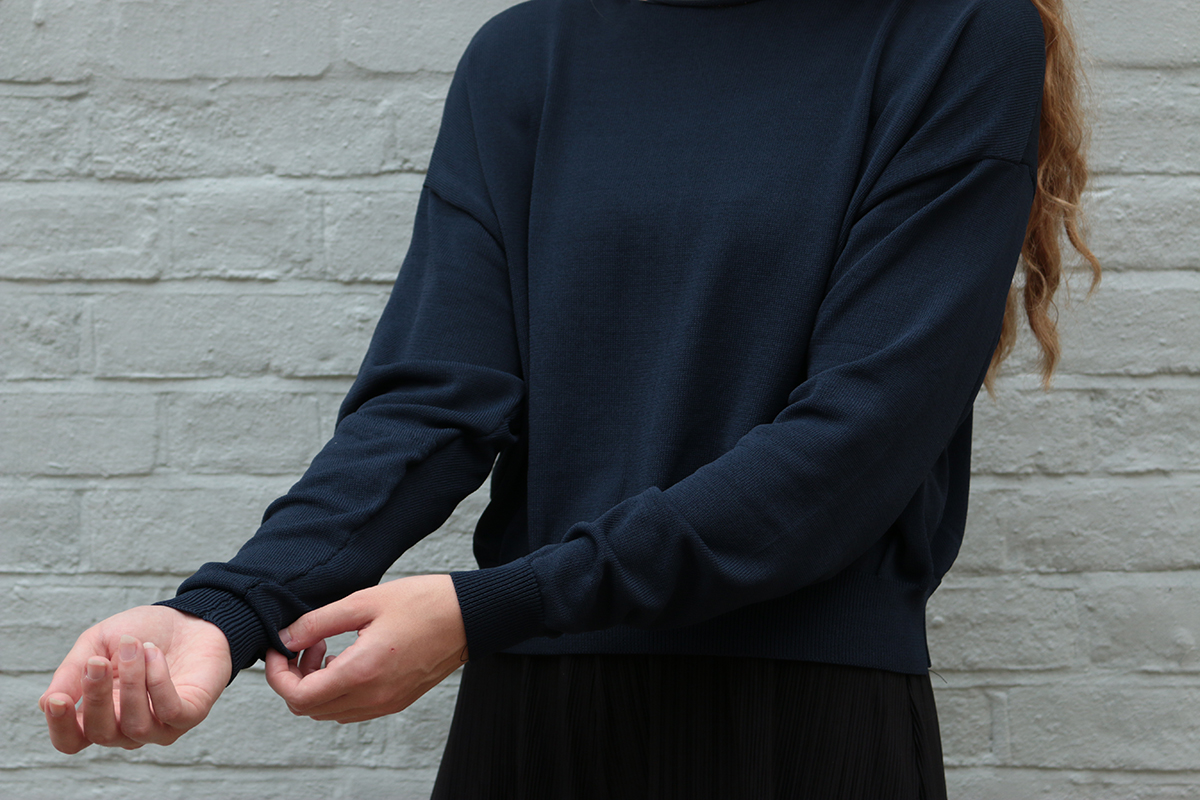
Wearable therapy garments for stroke rehabilitation are knitted by smart textiles start up KnitRegen. Founder Laura Salisbury and clinical advisor Rachel Stockley tell Jessica Owen the story.
A person experiences a stroke every 5 minutes in the UK, according to the Stroke Association. Not every person lives, but there are currently 1.3 million stroke survivors in the country – many of whom will need physiotherapy to regain mobility. Physiotherapy sessions vary in frequency and duration depending on the patient’s needs, but ideally a patient should receive round-the-clock treatment. That, unfortunately, is not possible. Or is it?
Smart textiles start-up KnitRegen aims to deliver continual rehabilitation. Founded in September 2020, the company is developing patent-pending textile components for stroke rehabilitation: it has created a knitted wearable therapy top that delivers a novel muscle stimulation treatment to the patient. The textile components build upon the work of Professor Stuart Baker, KnitRegen’s neuroscience partner, to provide therapy and improve recovery, notably for those most underserved by existing methods. The patient can wear the garment throughout the day to receive treatment instead of going to a hospital or clinic for an appointment. The aim is to boost gains made by a therapist.
Dr Rachel Stockley, senior research fellow at the University of Central Lancashire and clinical advisor at KnitRegen, says: “The body’s nervous system rewires and recovers 24 hours a day, seven days a week and we simply can’t provide therapy at that scale.”
She continues: “But something that is wearable for a stroke survivor, and that has the potential to improve their outcome, is a really attractive way of harnessing that neuroplasticity that underpins recovery.”
The idea for KnitRegen comes from Laura Salisbury who is completing a PhD in Textiles Design at the Royal College of Art (RCA) in London, UK. She began researching how textiles and garments could be used as tools to identify levels of mobility post-stroke and this led her to explore whether they could also facilitate recovery.
Salisbury says: “I am really interested in understanding how familiar, comfortable materials and technology can come together to have a huge impact. We worked through many concepts, worked closely with stroke survivors, carers and clinicians and eventually arrived at the concept we have now.”
The secret to KnitRegen’s wearable garments lies in a patent-pending bead. This 16.5 mm module (soon to be scaled down to seven mm) can be knitted to create clothing that delivers timed impulses to stimulate muscles. The team believes that short, timed impulses differ from other technology on the market and could provide more effective treatment. The bead is shaped so that it can be discrete on the outside of a textile while supporting the level of contact needed with the body. The company is currently working with 14 and 16 gauge knits and the bead is placed in strategic locations.
As part of KnitRegen’s patent, the team has created a pattern for a top that comprises a loose-fitting body and tighter, long sleeves. This enables the bead to be discretely integrated into the sleeve where it has contact with the body. The team is also experimenting with different knit densities and yarn combinations to see if a blouse or a cardigan could also be made.
Salisbury says: “We learnt from our focus groups with stroke survivors that they would prefer a garment that is familiar and something that could accompany their existing clothing. Something that doesn’t affect their silhouette and isn’t obviously a medical device.”
Stockley adds: “And while a tight-fitting garment makes sense because most technologies require body contact, these garments can be difficult for a stroke survivor to put on. It already takes them longer to get dressed than it did before having a stroke and they can become easily fatigued, so we did not want to make life more difficult for them.”
For the bead to work, it requires an energy source. Salisbury says there are two options to power the device: integrate a battery; or explore energy harvesting techniques. Initially, the team will use a battery until it can prove the technology works but says it is excited about energy harvesting. Energy harvesting relies on kinetic energy which could encourage patients to move more, thus enhancing their recovery.
KnitRegen is nearly one year old and has six employees. The company’s next step is to test the garment on healthy volunteers to determine its effectiveness. Once the team has completed this stage it plans to present the garment as a minimum viable product (MVP) and call a design freeze by summer next year. This means that by July 2022, the company will have a full specification of the product ready for optimisation.
Stockley says: “Anything that enters the health service as a medical device must undergo robust and rigorous testing on both healthy volunteers and patients. Once we have this data and know its effectiveness, we can advise therapists about how to use it and prescribe it to patients. But we already think it could be a really valuable tool.”
But it’s not just the technology that the team has to figure out. It must consider the logistics of manufacturing, too. Salisbury explains she is working with companies to understand existing processes and how KnitRegen’s products could fit into minimising disruptions to the supply chain.
She says: “I think the key learning point for us is understanding how we can use existing agile supply chains, maybe smaller supply chains, that have the ability to be more flexible. If that means there needs to be an element of upskilling, then we see that as a benefit. And we see that as another unique selling point (USP) as well as enabling those to provide our technology at scale.”
She continues: “At every stage we're thinking about safety first, cost and scale of manufacturing, value for the patient, and even about how the garment might be disassembled at end of life.”
Assuming all goes to plan, the company is investigating the route to market. Products will likely be made available through the healthcare system and it’s possible a percentage of the price of one garment could be used to subsidise a product for someone else who can’t afford it. Salisbury is also interested in collaborating with fashion-led brands to market the product as a lifestyle item as well as a medical device. She says rehabilitation is not just about regaining mobility but is about emotional support as well. If the product can look good and integrate within everyday life then it should enhance the wearer’s experience.
Although KnitRegen’s products will not be available for at least a year, the company has already demonstrated the importance of multidisciplinary collaboration – an approach that is seldom taken. Salisbury not only works with Stockley, but also with Stuart Baker, a professor of movement neuroscience at Newcastle University. She says their expertise and knowledge has been invaluable and has taken her concept to a much higher level.
Stockley says: “As a clinical researcher, it’s really important to have relationships with people like Laura. Improving rehabilitation is a really hard problem to solve and the way to tackle hard problems is to get more people involved, hear more diverse opinions and get different objective views.”
She continues: “Someone like Laura, who has used her design skills and is bringing that into a health space, is quite uncommon in my experience. But actually, I think it's exactly what we need to be doing to really tackle the big problems in health.”
Have your say. Tweet and follow us @WTiNcomment











